The Hague Is So Much More Than a Destination for War Criminals
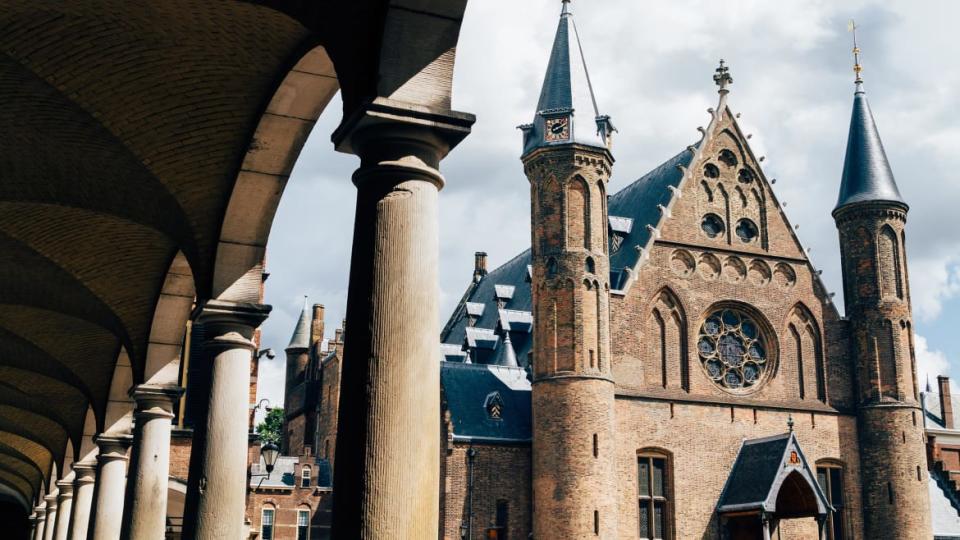
This is the latest installment of It's Still a Big World, our twice-a-month series on underrated destinations.
The wind was clocking in at around 20 miles per hour, so the bungee tower at the end of the pier was closed. It was a Tuesday in August in Scheveningen, a seaside district of The Hague, and the North Sea waves were so unruly that even the surfers had called it quits. I probably should have felt relief over this (my mother certainly did when I told her), but the self-imposed risk of jumping off a 200-foot tower seemed like a welcome reprieve from 18 months of pandemic-inspired fear.
Plus, I liked the idea of doing something exotic in The Hague, the third-largest city in the Netherlands, known largely for its powerful judicial institutions—the International Criminal Court and the UN’s International Court of Justice. It’s also still home to Parliament and the Dutch royal family, although, thanks to the whims of various counts, princes, kings, and politicians, as well as a couple of occupations and the Eighty Years’ War, Amsterdam became the official capital city in 1983.
Is Rotterdam Europe’s Most Beautiful Modern City?
So, go for the history and the civics lessons (and the Vermeers). Stay for the adrenaline rush.

The Scheveningen Pier, which juts out into the North Sea, is just one of the attractions of the Hague's beach district.
There was zero need for disappointment, though. My waylaid bungee-jumping plans gave me more time to linger over a lunch of grilled seabass with samphire, roasted fennel, and crab-shell foam at one of the dozens of so-called beach clubs. (Despite looking and feeling like permanent buildings, the seaside restaurants disappear in October.) Moreover, I’d gotten my adrenaline fix on the way to the beach that morning when I rode a bike through The Hague’s city streets, something I’d never attempt at home. Biking in New York City is a kamikaze mission—an extreme sport, even for a thrill-seeker. But throughout famously bike-friendly Holland, there’s no weaving around wheezing buses, burping sanitation vehicles, double-parked delivery trucks, and taxis whose doors swing open like vindictive jacks-in-the-box. In The Hague (that’s Den Haag to the Dutch) there are just bike lanes. And wide ones, no less. And local culture dictates that drivers give bikers the right of way. Nevertheless, as someone who hasn’t been on a bicycle since J. Lo and Ben Affleck’s very first go-around, there were some heart-skipping moments.
Nevertheless, if you’re going to reacclimate yourself to city biking, this is the place to do it, especially because there’s a massive park in the middle of the city that extends towards the sea. The Hague ranks among the world’s most densely populated areas, yet this city claims more greenspace than anywhere else in Europe. (No, that is not a riddle: More green space means less residential space, so more people packed into a smaller area, thus the density.) To get to the water, you pass through Scheveningen Woods, which encompass 50 acres of woodlands dotted with monuments and cut through with biking and walking paths. On approaching the sea, you see Meijendel start to unfurl for miles and miles. The nature reserve is a patchwork of dunes, forests, and lakes. Underground there are bunkers the Germans built during World War II.
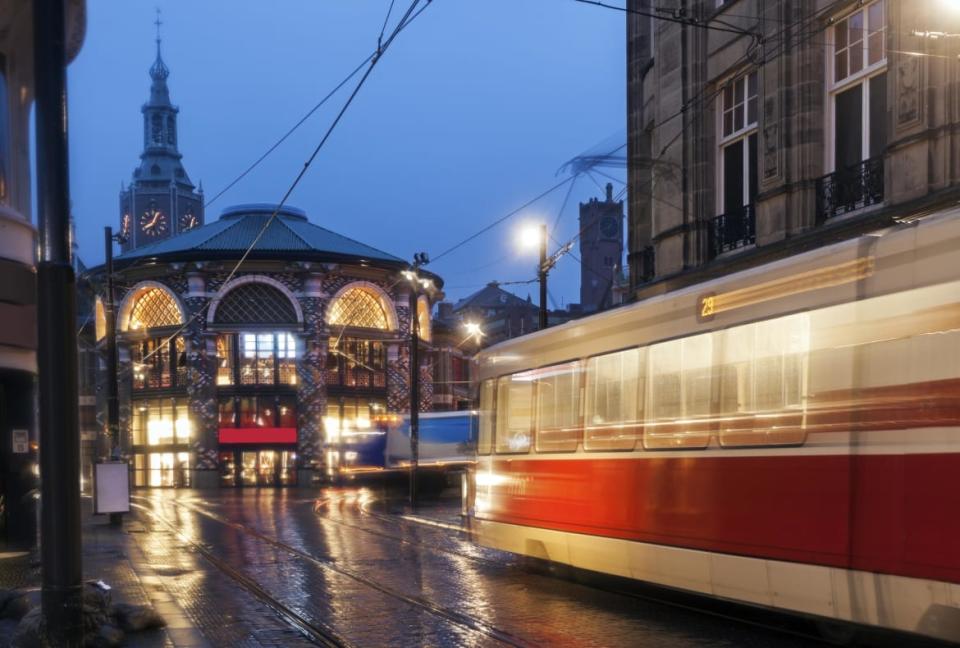
A sunrise street scene in The Hague, Netherlands.
It’s disorienting and remarkable: As remote as that landscape feels, this city is as central to the global community as New York or Geneva. Less than three miles from the quiet dunes, where wild horses are in no hurry, sits the Peace Palace, build with financial support from Andrew Carnegie in 1913 to house the Permanent Court of Arbitration. In 1943, the International Court of Justice, the UN’s judicial body, moved in. The building is a display of the global harmony the occupants aim to establish, a fusion of international ideas: The grand stairway is made of marble from Italy. Germany provided the forged gates, the clock tower is Swiss craftsmanship, and stained-glass windows featuring kilted warriors are, of course, from Scotland. It’s stunning.
I was only a few hours into my four-day stay—a sufficient duration for getting to know the city—when I realized that this is a city of contrasts. On the way back to my hotel that night to drop off my bike, I passed the former American embassy, a Brutalist structure as bulky and uncompromising as the Peace Palace is graceful and precise. My hotel, Voco The Hague, which opened in July, also delivered an engaging study in how fuse old and new, industrial and natural, bulk and light. Retrofitted into a bank built in 1923, the atrium has a maple tree in the middle, an installation of thousands of metal butterflies and a glass ceiling, all of which gives the somber original infrastructure a jolt of enchantment.
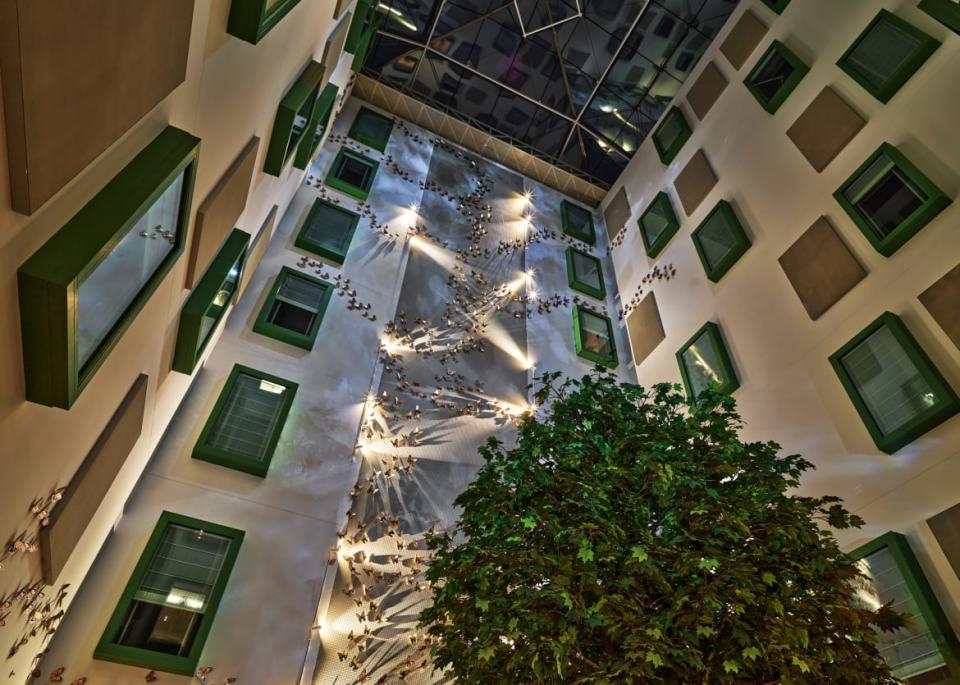
Hotel voco – The Hague.
The next day I left the pedaling to someone else. I arranged a tour through The Hague Street Art (THSA), an organization devoted to urban beautification and showcasing young artists. I would travel by rickshaw. At one point in the coming days, I would visit the Mauritshuis, the museum known for its collection of Dutch Golden Age paintings—Rembrandt, Rubens, Van Dyck and, most famously, Vermeer’s “Girl With a Pearl Earring” and “View of Delft.” But this afternoon was a full immersion lesson in the creative energy that electrifies the city right now.
Jurjen Simmelink, owner of tour company Enter The Hague, stand-up comedian, animal rescuer, evangelist for local culture, and bearer of impressive calf muscles, met me with his vibrantly painted cart attached to his bike. For the next few hours, he would steer me and Yscha Aelène, a project manager for THSA, through the city streets then out to Binckhorst, a longtime industrial area where artist studios, nightclubs, and an indoor surf pool sit across the freeway from car dealerships. Luxury developments are under construction. (“Street art protects these buildings from graffiti,” Jurjen said.)
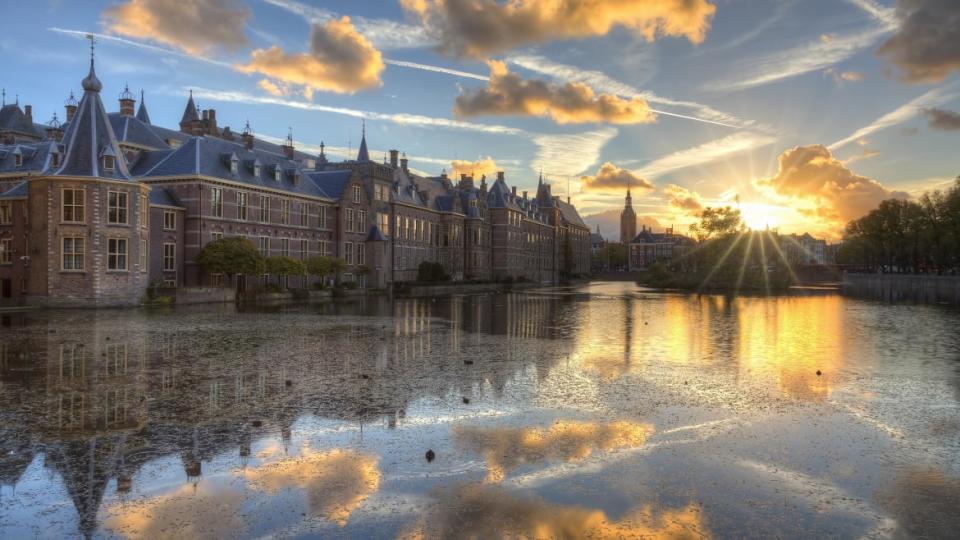
Dutch Houses of Parliament with on the far left 'Het Torentje' (The Little Tower, office of the Dutch Prime Minister) reflected in the Court Pond (Hofvijver).
That protection is colorful, engaging, thoughtful, and fiercely local. A diverse display of murals by the area’s artists include Erwin Verkade’s minimalist illustrations, a vivid, confident portrait of actor Elliot Page by Collin van der Sluijs, and the poignant realism of Lily Brik.
We wrapped up at The Hague Market, a rambling series of stalls that’s said to be the biggest market in Europe. And a $1.3 million investment in solar panels has it on track to be the greenest one, too. Here you can buy anything from Italian plums to German strawberries and sausages to knitwear from Thailand to underwear and washing machines. There’s also a cheery candy shop where “medicijnman” Philip Kalman peddles salty black licorice in dozens of shapes, sizes, and intensities. It’s a treasure trove if you’re into it. And many are. The line wound all the way through the shop. I abstained because the stuff reminds me of Play-Doh dipped in eucalyptus dish detergent. But I also dislike olives.
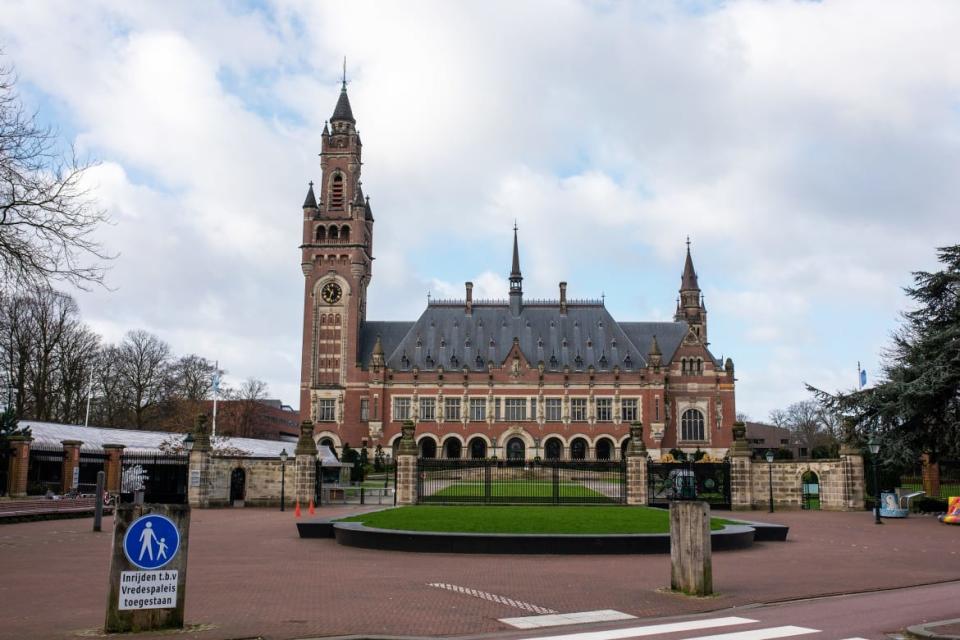
The Peace Palace, an international law administrative building, in The Hague, Netherlands.
The Market is where Shelley Vrolijk, a jovial fishmonger, has her stall. Even as the city has changed over the decades, one tradition never wanes: brined herring. Shelley’s grandfather opened the stand 75 years ago, and she took it over in 2011 from her parents. Her father still goes down to the Scheveningen docks each morning to pick up the fish to be fried, smoked, and cured.
She explained that while people in other cities smother their herring with chopped onions, slice it (gasp!), or even eat it in sandwiches (the horror!), the proper way to eat it is “by the tail.” (“My dad says it’s the correct way. If you want onions, you get a lecture,” she deadpanned.) Tilt your head back, she instructed, and dangle it by the tail over your mouth. Jurjen demonstrated. Fully recognizing that I am a stranger in someone else’s home, I looked skywards, rolled my head, and with those salty bites, communed with Dutch seafaring traders of centuries ago as exuberant blond children chased each other around a picnic table. Their parents were blissfully unfazed, completely engrossed in their fried fish.

Shelley Vrolijk, a fishmonger in The Hague Market, sells herring and other seafood at a stall her grandfather opened 75 years ago.
Or at least we might have wrapped up there. On the way back to my hotel in the central Royal Quarter, my guides pointed out a mural down a narrow restaurant-lined alley: a portrait of a woman’s face. Yscha and Jurjen wanted to show me something cool, they said. They delivered.
The face is painted on a vast corrugated metal surface. Stand towards the right and the woman looks ahead; walk a few steps to the left, and the other side of the slats reveal her profile. And on this particular day, take a few steps backward and you could see the real-life model herself and the boyfriend who painted her. (Not an hour before, Yscha was telling me you can hardly walk or bike 10 minutes in the city without waving to someone you know. Point proved.)

A SOGOshow mural created by Gordon Meuleman and Sophia Den Breems is just one example of how local artists are raising the profile of the Hague's street art scene.
Sophia Den Breems and Gordon Meuleman are artists who call themselves Sogoshow when they collaborate, as they did on this portrait. I joined them for a pint at a table outside Impio, a stylish, internationally-minded tapas restaurant that opened in the alley in April. They told me about the pandemic-interrupted beer project they were working on for a little local brewery called Heineken, how they work together as a couple. (“Through the years, our work blended into a style of its own,” Gordon told me. “It’s not Sophia plus Gordon, Sogo is a third artist living in our heads.”) They were both born in The Hague and never imagined they’d see the day when people throughout the city would stop and get off their bikes to snap photos of murals, theirs among them.
Chef-owner Bjurran Piron came out to greet the group (all friends) and bring another platter of fried smelt with juniper and Sichuan peppers. We talked a while about what it was like to open a restaurant during the pandemic and about his time living in Cambodia. That’s where he got the tattoo on his arm that reads “Never go home again” in Dutch. At that moment, surrounded by creative people in a historic city, it read to me like a welcome mandate.
Get our top stories in your inbox every day. Sign up now!
Daily Beast Membership: Beast Inside goes deeper on the stories that matter to you. Learn more.

 Yahoo Finance
Yahoo Finance 